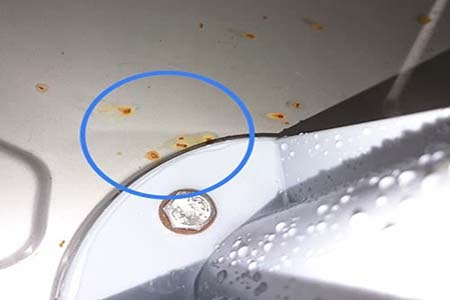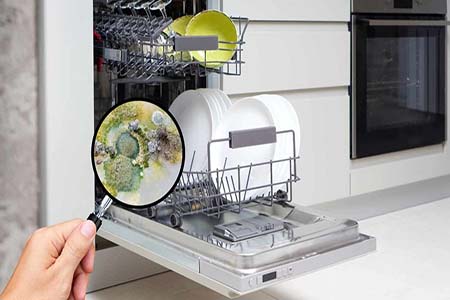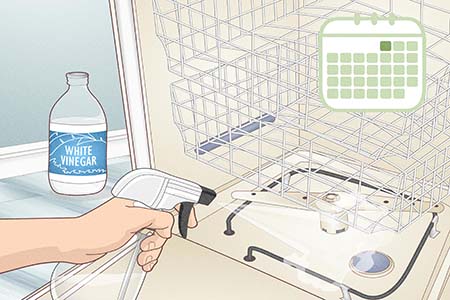In this comprehensive guide, we will delve into the world of mold in dishwashers, understanding why it occurs, its implications on cleanliness and hygiene, and most importantly, how to prevent and eliminate this issue.
Discovering Mold in Your Dishwasher: A Common Yet Unexpected Problem

- Mold’s Surprising Presence: Mold is a pervasive household nuisance, and it can sometimes take us by surprise when it shows up in the most unexpected places. One such place is inside your dishwasher.
- Challenging Cleanliness Perceptions: This revelation can be particularly disconcerting as your dishwasher is supposed to be the epitome of cleanliness and hygiene.
- Warm, Moist Environment: Due to its warm, moist environment, coupled with food debris, it becomes a fertile breeding ground for mold.
- Impact on Cleanliness and Hygiene: Mold’s ability to thrive in your dishwasher may seem paradoxical, given that this appliance is designed to clean and sanitize your dishes. However, the very conditions that make it an effective cleaner—warmth and moisture—also create an ideal habitat for mold to grow.
- Health Concerns: When you add leftover food particles into the mix, you have a recipe for mold development that can take you by surprise if you’re not vigilant. Mold spores can become airborne during the dishwasher’s cycles, settling on your dishes and potentially causing health concerns, especially for individuals with mold allergies.
- Unpleasant Odors: Moreover, mold doesn’t limit its impact to health concerns alone. It can also lead to foul odors that infiltrate not only your dishes but your entire kitchen.
- Diminished Dining Experience: These unpleasant smells can transfer to your freshly cleaned plates and utensils, diminishing the overall dining experience.
Why Mold in Your Dishwasher Matters
The Impact on Cleanliness and Hygiene
- The presence of mold in your dishwasher is not merely a matter of aesthetics. It has significant implications for the cleanliness and hygiene of your dishes. Mold spores can become airborne during the dishwasher’s cycles, landing on your dishes and potentially causing health concerns, especially for individuals with mold allergies. This means that even after your dishwasher completes its cycle, your dishes may not be as clean as you’d like to believe.
The Role of Mold in Household Odors
- Mold doesn’t stop at affecting the cleanliness of your dishes; it can also lead to foul odors that permeate not only your dishes but your entire kitchen. These unpleasant smells can transfer to your freshly cleaned plates and utensils, diminishing the overall dining experience. So, mold in your dishwasher isn’t just a visual concern; it impacts the ambiance and enjoyment of your meals.
Understanding Mold in Dishwashers
Factors That Encourage Mold Growth

To effectively combat mold in your dishwasher, it’s essential to comprehend how and why it develops. Several factors contribute to mold growth, and understanding these factors is the first step in mold prevention.
- Residual Food Particles: One of the primary factors that encourage mold growth in your dishwasher is the presence of residual food particles. These tiny bits of food can accumulate in the dishwasher’s filters and seals, creating an ideal environment for mold to thrive. Mold feeds on organic matter, and leftover food provides a consistent source of nutrients.
- Warm and Moist Environment: Your dishwasher’s warm and moist environment, designed to clean and sanitize your dishes effectively, inadvertently creates favorable conditions for mold growth. Mold thrives in damp environments, and the combination of warmth and moisture inside the dishwasher is perfect for its development.
- Lingering Food Particles: Lingering food particles are not only a source of nutrition for mold but also a source of moisture. Even after a dishwasher cycle, some food remnants may remain trapped in corners and crevices, providing both sustenance and the humidity necessary for mold to flourish.
- Neglected Maintenance: Failure to perform regular maintenance on your dishwasher, such as cleaning filters and seals, can exacerbate the mold problem. When filters become clogged with debris, water drainage is compromised, leading to increased moisture retention and mold growth.
- Hidden Mold Hotspots: While some mold trouble spots in your dishwasher are readily apparent, others remain hidden from plain sight. Understanding these concealed areas is crucial for effective mold prevention. Often, these areas include crevices, seams, and corners where water and food debris can accumulate.
Eliminating Mold

Quick Actions: What to Do When You Spot Mold
If you’ve already discovered mold in your dishwasher, it’s crucial to act swiftly. Here’s what you should do:
- Turn off and unplug your dishwasher to ensure safety.
- Remove all dishes and racks from the dishwasher.
- Inspect the interior carefully, with special attention to the rubber seals, gaskets, and any crevices where mold may hide.
- Wear protective gloves and use a scrub brush or toothbrush to gently scrub away visible mold growth.
- Create a cleaning solution by mixing equal parts water and white vinegar or use a specialized dishwasher cleaner recommended by the manufacturer.
- Dip the scrub brush or toothbrush into the cleaning solution and continue to clean affected areas thoroughly.
- Use a clean, damp cloth to wipe down the interior of the dishwasher, including the door, walls, and all surfaces.
- Once cleaned, leave the dishwasher door open to allow it to air dry completely.
A Deep Clean: Tackling Seals, Gaskets, and Dishwasher Interiors
Seals and gaskets in your dishwasher are common hotspots for mold growth due to their design and constant exposure to moisture. To ensure you eliminate mold effectively, it’s essential to:
- Inspect these components for mold growth and debris.
- Create a cleaning solution using water and vinegar or a specialized dishwasher cleaner.
- Gently scrub the affected seals and gaskets with a toothbrush or scrub brush.
- Rinse thoroughly with clean water.
- Allow the seals and gaskets to air dry completely before reassembling your dishwasher.
Filter Focus: Efficient Techniques for Mold-Free Dishwashers

Dishwasher filters play a vital role in trapping food particles and debris, preventing them from recirculating onto your dishes. Cleaning these filters according to the manufacturer’s instructions is essential for a mold-free dishwasher. Typically, you should:
- Locate and remove the filters from your dishwasher.
- Rinse the filters under warm, running water to remove any visible debris.
- If your filters are dishwasher-safe, place them in the top rack during a hot water cycle without any dishes. Add a cup of vinegar to enhance the cleaning process.
- For non-dishwasher-safe filters, soak them in a mixture of warm water and vinegar for about 15 minutes before rinsing thoroughly.
- Once cleaned, reinsert the filters into your dishwasher, ensuring they are properly seated.
Giving Your Dishwasher an Extra Boost: Running an Empty Cycle
To further ensure your dishwasher is mold-free, consider running an empty cycle with a cup of vinegar placed in the top rack. This will help clean and disinfect the interior, eliminating any lingering mold spores.
Preventing Mold Growth
A Clean Start: Preparing Dishes Properly
- Preventing mold growth begins long before you load your dishwasher. Properly preparing your dishes, such as scraping off excess food and rinsing them thoroughly, can significantly reduce the chances of mold formation. Removing this initial source of food debris is the first line of defense.
Regular Dishwasher Maintenance: Cleaning and Care Tips
- Regular maintenance of your dishwasher’s interior, including its racks and filters, is essential to prevent mold. Utilizing dishwasher-safe cleaners or natural solutions like a mixture of vinegar and baking soda can effectively remove any residue, ensuring a mold-free environment.
Creating the Ideal Dishwasher Environment: Ventilation and Door Habits
- Proper ventilation is crucial to allow moisture to escape, thereby reducing the likelihood of mold growth. A simple practice like leaving the dishwasher door slightly ajar after a cycle can make a substantial difference in maintaining a mold-free dishwasher.
The Mold-Preventing Power of Rinse Aids
- Rinse aids can be a valuable asset in your battle against dishwasher mold. These products enhance the drying process, allowing your dishes to dry faster and reducing the moisture levels inside the dishwasher. As moisture is a significant contributor to mold growth, using rinse aids can be an effective preventive measure.
Maintaining a Mold-Free Dishwasher in the Long Run
Establishing a regular cleaning and maintenance routine is crucial to prevent mold from returning and to ensure the longevity of your dishwasher. Here’s a checklist to help you maintain a mold-free dishwasher:
- Clean your dishwasher’s interior, including racks and filters, every month or as recommended by the manufacturer.
- Check seals and gaskets regularly for any signs of mold or deterioration.
- Practice good loading habits, ensuring dishes are properly spaced to allow for efficient water circulation and drying.
- Use rinse aids to enhance drying and reduce moisture levels.
- Leave the dishwasher door slightly ajar after each cycle to facilitate ventilation.